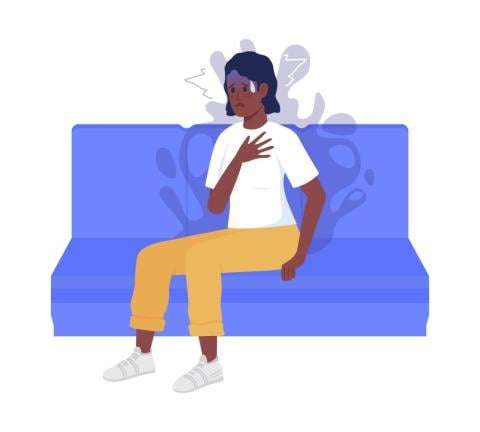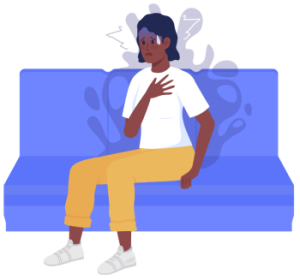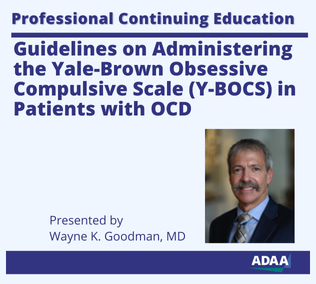You Can Teach an Old(er) Dog – With OCD – New Tricks! (Or Why I Attended an OCD Treatment Program in My Late 40s)
 My name is Christine and I wanted to share my story about attending an OCD Treatment Program with an intensive ERP (Exposure and Response Prevention) focus. I hope it will encourage others who are in their 40s and beyond to pursue treatment if it is needed.
My name is Christine and I wanted to share my story about attending an OCD Treatment Program with an intensive ERP (Exposure and Response Prevention) focus. I hope it will encourage others who are in their 40s and beyond to pursue treatment if it is needed.
My journey with OCD began when I was 5 years old – 40+ years ago-– at which time I began to have irrational fears and guilt about being a “bad” child. These irrational thoughts and corresponding anxiety and depression continued through adolescence when my OCD thoughts took a disturbing turn and I started having “harm” obsessions with checking compulsions. These obsessions upset me to the point that I voluntarily checked myself into a psychiatric facility at the age of 17 (with parental consent). It was there that I was first diagnosed with obsessive compulsive disorder.
Fast forward 30+ years and I am still grappling with the disorder – but my obsessions and compulsions have changed. I now have problems with perfectionism and excessive checking of my work projects as well as obsessions and checking compulsions related to leaving my home. In my continuous search for treatment options I was referred to a program with a solid reputation for OCD treatment with an emphasis on ERP (Exposure and Response Prevention). The program focused completely on OCD related issues and employed ERP as one of its primary treatment modalities.
As I had never had the opportunity to attend an intensive OCD treatment program, I decided to enroll. The majority of the program’s day for me was focused on ERP which is “A type of behavioral therapy that exposes people to situations that provoke their obsessions and the resulting distress while helping them prevent their compulsive responses.”(Carey 2019. NOCD website). The ERP process starts by each patient creating an exposure hierarchy (anxiety “ladder”) which basically is a list of anxiety provoking scenarios specifically linked to a particular obsessive/compulsive cycle.
The patient then chooses 5-10 exposures from within the hierarchy that he or she would like to work on during their time in the program. I created two personal exposure hierarchies during my time in the program. One exposure hierarchy focused on “Checking” and the second hierarchy focused on “Confrontation.”
I immediately began therapeutic work with my Checking Exposure Hierarchy. As I have a problem with checking my purse and keys repeatedly when I leave a location, the challenge was to leave these items in my room, without checking them once and sit in the lobby area for five to 20-minute intervals. During the time I performed this activity, I was not allowed to obsess about the security of the items but rather to “sit with my anxiety” - in other words let any anxiety I felt about this situation to flow through me for the duration of the exercise. The overall idea is to perform the exposure, experience the resulting anxiety and NOT perform the mental or physical compulsion one would typically do to in order to alleviate the anxiety.
Working on my Exposure Hierarchy related to Confrontation was more anxiety provoking. My most difficult confrontation exposure was a role-play where a supervisor is extremely rude to me. In order to perform this exposure I asked staff members to role play a scenario involving me making an error and then to verbally attack me. I decided to make the role play even more anxiety provoking by asking the staff to yell and slam things to express their anger. After each role play I would go back to my treatment room again and “sit” with the feelings of anxiety and anger until the feelings eventually lessened. While sitting with these feelings, I was not allowed to obsess about the verbal exchanges I had just completed.
I have to admit asking people to yell at you and slam things around is an intense experience at times – but it helped. I noticed as I continued to expose myself to these interactions and actually experience the resulting anxiety – my overall fear of confrontation appeared to decrease.
In summary, I feel that my experience in an OCD treatment program with an ERP focus was definitely a positive one. I successfully completed exposures forcing me to face some of my worst OCD fears. I feel that I lessened my OCD urges and took some control back over my emotional well-being. I hope that my story, much like the “OCD Stories from the Community” featured on the ADAA website, will provide hope and encouragement for others on their journey to mental health and peace.
Share Your Story and Voice and Help #breakthestigma Around Mental Health
Support ADAA's Mission - Every Gift Makes an Impact
















